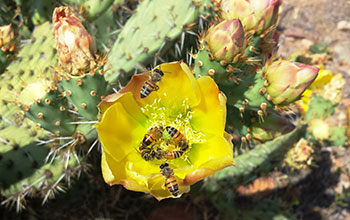Multimedia Gallery
Non-native honeybees gather nectar from a native coast prickly pear cactus
Non-native honeybees gather nectar from a native coast prickly pear cactus (Opuntia littoralis) in Southern California.
More about this image
Biologists at the University of California, San Diego, released an unprecedented study integrating data from around the globe that shows honeybees are the world’s most important single species of pollinator in natural ecosystems and a key contributor to natural ecosystem functions. It is the first quantitative analysis of its kind.
The results of the report, which merges information from 80 plant-pollinator interaction networks, clearly identify the honeybee (Apis mellifera) as the single most frequent visitor to flowers of naturally occurring (non-crop) plants worldwide. Honeybees were recorded in 89% of the pollination networks in the honeybee's native range and in 61% in regions where honeybees have been introduced by humans.
One out of eight interactions between a non-agricultural plant and a pollinator is carried out by the honeybee, the study revealed. The honeybee's global importance is further underscored when considering that it is but one of tens of thousands of pollinating species in the world, including wasps, flies, beetles, butterflies, moths and other bee species.
"Biologists have known for a while that honey bees are widespread and abundant -- but with this study, we now see in quantitative terms that they are currently the most successful pollinators in the world," said Keng-Lou James Hung, who led the study as a graduate student in UC San Diego's Division of Biological Sciences. He's now a postdoctoral researcher at the Ohio State University.
The study, which was supported by the U.S. National Science Foundation, was conceived as a result of collecting preliminary data for an NSF Doctoral Dissertation and Improvement grant (DEB 1501566, "The effects of pollinator diversity loss on plant-pollinator interaction networks and native plant reproduction in scrub ecosystems of Southern California") from NSF's Division of Environmental Biology. Once the grant was funded, data collected as part of the grant were included as part of the meta-analysis.
To learn more about this research, see the UC San Diego news story Worldwide importance of honeybees for natural habitats captured in new report. (Date image taken: 2013; date originally posted to NSF Multimedia Gallery: March 15, 2018)
Credit: James Hung/UC San Diego
See other images like this on your iPhone or iPad download NSF Science Zone on the Apple App Store.
Images and other media in the National Science Foundation Multimedia Gallery are available for use in print and electronic material by NSF employees, members of the media, university staff, teachers and the general public. All media in the gallery are intended for personal, educational and nonprofit/non-commercial use only.
Images credited to the National Science Foundation, a federal agency, are in the public domain. The images were created by employees of the United States Government as part of their official duties or prepared by contractors as "works for hire" for NSF. You may freely use NSF-credited images and, at your discretion, credit NSF with a "Courtesy: National Science Foundation" notation.
Additional information about general usage can be found in Conditions.
Also Available:
Download the high-resolution JPG version of the image. (2.5 MB)
Use your mouse to right-click (Mac users may need to Ctrl-click) the link above and choose the option that will save the file or target to your computer.



 All images in this series
All images in this series